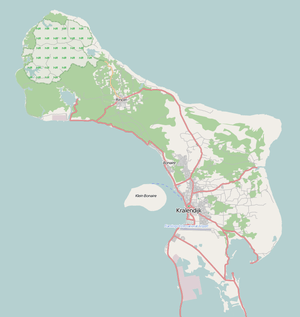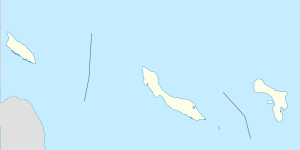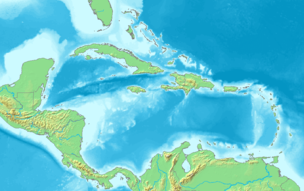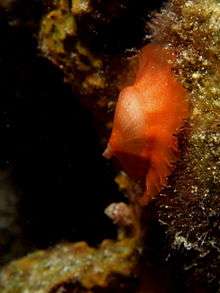Bonaire National Marine Park
The Bonaire National Marine Park or BNMP is the oldest marine reserve in the world. It includes the sea around Bonaire and Klein Bonaire from the high water line to a depth of sixty meters. The park was established in 1979 and covers 2600 hectares coral reef, seagrass - and mangrove vegetation.[2] The lagoon Lac is also part of the underwater park.
| Bonaire National Marine Park | |
|---|---|
IUCN category II (national park) | |
.jpg) Underwater life of Klein Bonaire - composite of 8 photos from snorkeling on a flat coral reef off the islet Klein Bonaire. | |
   | |
| Location | Bonaire, Caribbean Netherlands |
| Nearest town | Rincon |
| Coordinates | 12°10′N 68°15′W[1] |
| Area | 27 km2 (10 sq mi) |
| Established | 1979 |
| Operator | STINAPA Bonaire |
| Website | Bonaire National Marine Park |
In 1999 the underwater park received the status of national park from the Netherlands Antilles. The uninhabited island Klein Bonaire was added to the underwater park as a legally protected nature reserve in 2001. The west side of Bonaire is littered with diving sites that are easily accessible from the beach. The dive sites around Klein Bonaire are accessible by boat for divers. With the exception of a small area, the BNMP is completely open to divers with a total of 86 public dive sites.[3]
Geography
.jpg)
The national park covers the waters around Bonaire from the high water mark to a depth of 60 meters.[4] Also some coastal stretches with mangrove forests, for example in the lagoon Lac. Part of the park is also the uninhabited island Klein Bonaire. The national park also contains several important wetlands, which are particularly protected under the Ramsar Convention. In general Bonaire reef ecosystem has fewer macroalgae, a higher coral cover and more young corals per square metre than comparable reefs on UNESCO List of World Heritage in Danger such as Belize Barrier Reef Reserve System.[1]
Flora and Fauna
Open Water
The flora and fauna of the open water off the coast of Bonaire are not well researched. The water, as typical of the region, is quite warm and contains few natural nutrients, but large quantities of phytoplankton live in this area. Large fish occasionally observed in this area include tuna, wahoo, marlin and swordfish. Also whale sharks have already been spotted in the waters.
Seabed

At the bottom of the Bonaire National Marine Park are extensive seagrass beds, which are of the seagrass species Thalassia testudinum and Syringodium filiforme and green algae of the genus Halimeda dominated. For many species of fish they are important for the egg-laying and rearing of their young. In addition, large populations of marine snails, such as beautiful flamingo tongue snails (Cyphoma gibbosum) live here.[5]
Coral Reefs
Bonaire is surrounded by fringing reefs. These consist of about 60 different coral species, including brain corals, elkhorn corals, fire corals and gorgonians. The reefs offer a variety of marine life. Some of the most common fish species are surgeonfish, parrotfish, reefperch and wrasses. In addition, countless invertebrates such as shrimp, crayfish and squid live here. Bonaire's coral reefs were seriously damaged in 1999 by hurricane Lenny. Furthermore, they are threatened by the effects of pollutants and the warming of the sea.
Lac bay
In the lagoon of Lac Bay is the only significant concentration of mangroves on Bonaire. Here grow red, black and white mangrove as well as button mangrove. The 700-acre lagoon has been a Ramsar site[6] since the 1980s, offering habitat to green sea turtle and other endangered species, such as queen conch (Strombus gigas).[7]
Tourism
Already in 1939, the famous diving pioneer Hans Hass visited Bonaire and reported in his books on the rich underwater world.[8]
Bonaire National Marine Park known as one of the hotspots for divers in the Caribbean and as one of the world's best places for snorkeling. For example, Forbes magazine ranked BNMP among the top 10 must-dive destinations in the world in 2017.[9]
In the Bonaire Marine Park, Dixon et al. (1994) found that most divers seldom venture further than 300 m in one direction and that there was a decreasing physical impact on reef communities with increasing distance from a mooring buoy. Analyzing coral cover, they estimate that the diver carrying capacity threshold for the Bonaire Marine Park is between 4000 and 6000 dives per site per year.[10][11]
In addition, various activities such as kitesurfing, sailing and windsurfing are offered in the area of the Bonaire National Marine Park.
Unique to the Bonaire National Marine Park is that it runs entirely on its own income (without subsidies). The income comes from an entrance fee for divers. Other users, such as swimmers, surfers, kite boarders, kayakers and water sports enthusiasts, pay a lower entrance fee.[12] This also gives access to the Washington Slagbaai National Park. In addition to nature protection, the BNMP provides information about responsible diving to tourists and the maintenance of moorings (buoys) for boats with divers.[13] The management is in the hands of the Stichting Nationale Parken Bonaire (STINAPA) which also manages the Washington Slagbaai National Park.[4]
References
- Bonaire Marine Park UNESCO World Heritage Center
- Bonaire in Bonaire, Sint Eustatius, and Saba Protected Planet
- Marine Park CORAL REEFS PARK RULES BONAIRE DIVE SITES STINAPA Bonaire
- Kalli De Meyer, Duncan MacRae Bonaire National Marine Park Management Plan 2006 STINAPA Bonaire
- Flamingo Tongue Dutch Caribbean Nature Alliance
- Lac MANGROVE FOREST CORAL REEF NURSERY STINAPA Bonaire
- Lac Tourism Corporation Bonaire
- Jung, Michael and Kalli de Meyer: Hans Hass and his Journeys to Bonaire and the History of the Bonaire Marine Park and the Development of the Diving Industry on Bonaire. Merzig, 1999
- Breanna Wilson 10 Must-Dive Destinations For 2017 Forbes Media LLC
- S.C. Jameson et al.,A coral damage index and its application to diving sites in the Egyptian Red Sea Coral Reefs (1999) 18, pages 333—339 Springer-Verlag.
- J.A. Dixon et al. (1994) Ecology and microeconomics as joint products: the Bonaire Marine Park in the Caribbean. In: C. Perrings, et al. (eds) Biodiversity conservation: problems and politics. Kluwer Academic Press, Dordrecht
- Water Sports in Bonaire Tourism Corporation Bonaire.
- Dive Map STINAPA Bonaire
External links
| Wikimedia Commons has media related to Bonaire National Marine Park. |
| Wikivoyage has a travel guide for Bonaire National Marine Park. |